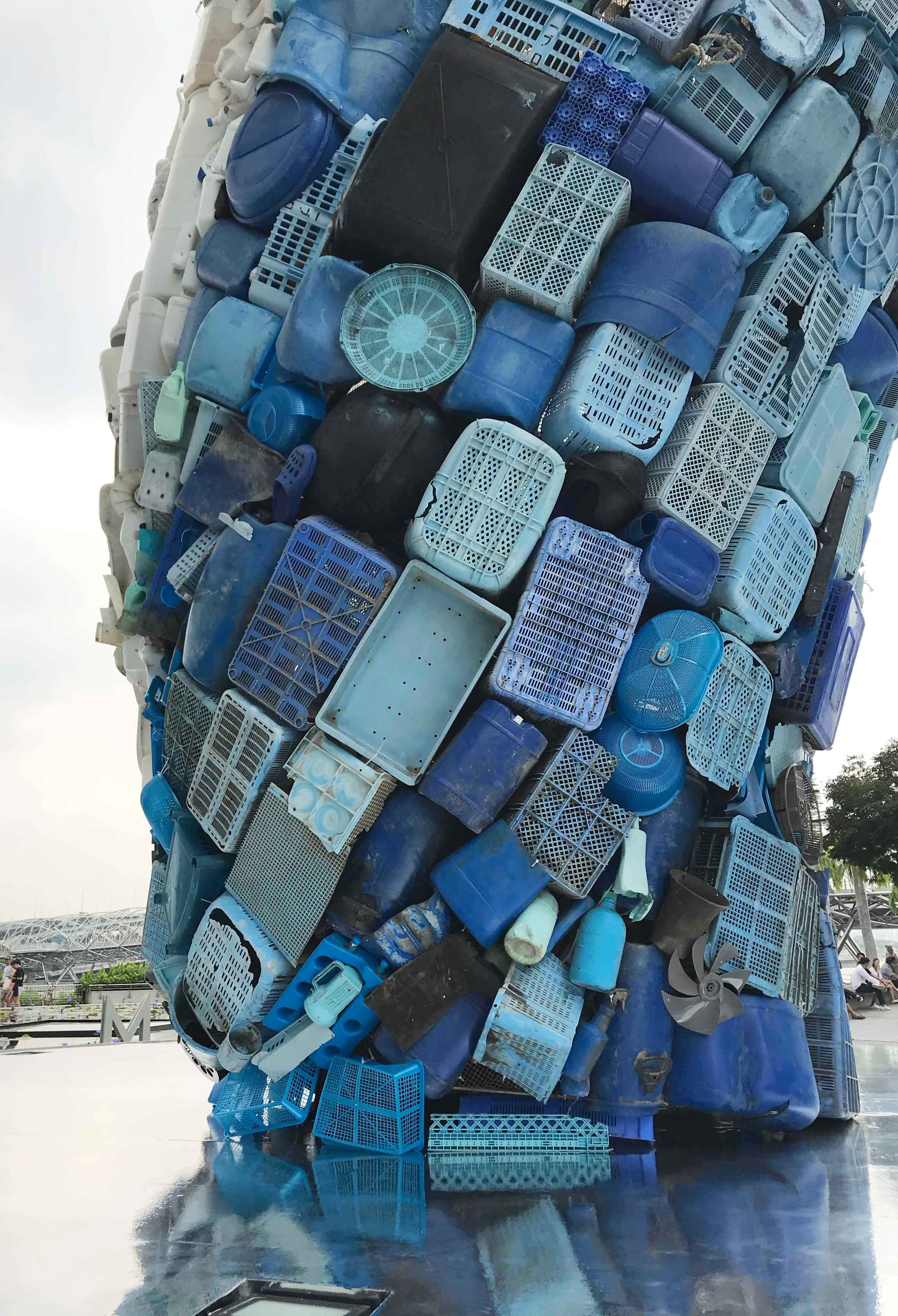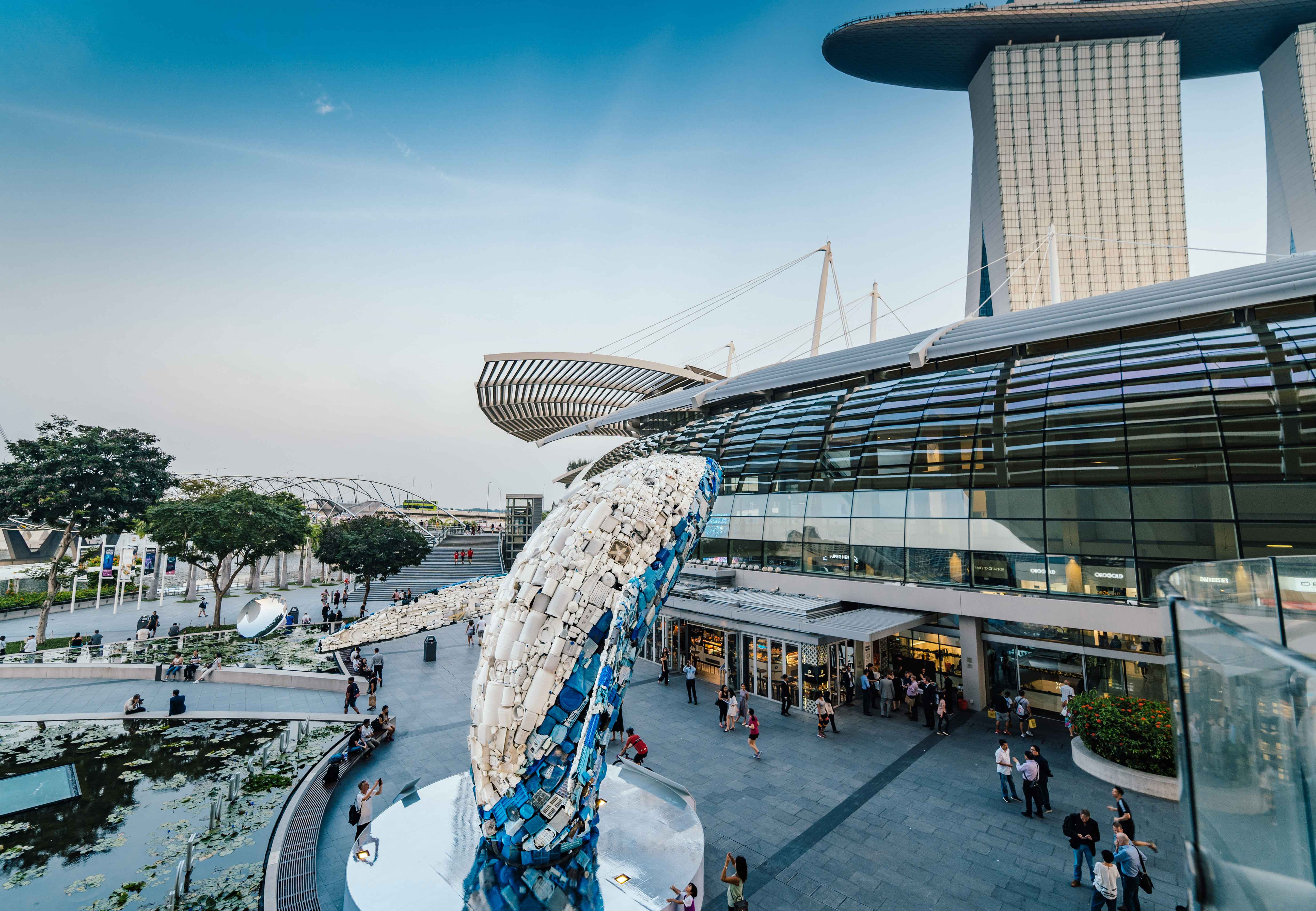A sculpture of a whale towers over the grounds at the ArtScience Museum in Singapore. It stands at 11 meters tall, in a favorable pose caught in mid-action. Except that it is no fancy artwork done by modern surrealist artists, or a lavish creation made from Carrara marble, but one made of trash foraged from the ocean.
From baskets to rubber shoes, barrels to flashlight holders, a random collection of discarded items decorate the body of the “Skyscraper”, an art piece that was designed and constructed by business partners and architects, Jason Klimoski and Lesley Chang, of StudioKCA from New York City. It is a think piece that was done in collaboration with Ocean Recovery Alliance, a non-profit organization for marine life conservation.
A total of five tons of plastic materials were farmed from a series of beach clean ups – an initiative by the Hawaii Wildlife Fund and the Surfriders Foundation – on nearby coasts off Hawaii over a period of four months. “Almost anything you can think of that is made from plastic can be found in the ocean and we used all of it to create “Skyscraper”,” says Jason.
The sculpture took the team almost a year to materialize the idea to fruition, where the assembly of random plastics (after rigorous sorting and selection) were fitted onto a skeleton of 16 large, double curved aluminum panels. It made its debut at the Bruges Triennial in 2018, a contemporary art show hosted in the city of Bruges, Belgium.
Singapore is the first stop in Asia for the “Have We Breached the Limit?” art installation. We speak to the artist Jason Klimoski and Douglas Woodring, organizer and founder of the Ocean Recovery Alliance, about the travelling project and what the bigger message really is.
In such initiatives, the greater goal is to be ambitious yet rational about saving the planet as we know it. For a long-running mission like this, what’s a common misconception the public has about ocean conservation?
Douglas Woodring (DW): Although the ocean is in the headlines and is the recipient of all of our poor waste management practices upstream, the ocean has very little to do with the solution. The main area to tackle is up on land, which is where the majority of the trash originates from. Whales are just one among the thousands of species, land and sea, which are impacted by plastic pollution.
Jason Klimoski (JK): I agree, the plastic waste in the ocean can be marine products, but the vast majority we encountered in the collection effort are common household items. It was a surprise how many cups, shoes, toilet seats, and toothbrushes we were pulling out of the ocean. That means every decision we make in our daily lives to avoid or reuse plastic products is a step closer to a cleaner ocean.
What advice can you give the interested layman who wants to save the planet in their day-to-day lives?
DW: Firstly, they can make a conscious effort not to use single-use items. This includes avoiding styrofoam lunch boxes, packaging on fruit and vegetables, and small plastic bags used for drinks like bubble tea and at fast food restaurants, which is apparent in Asia.
Secondly, people can work within their companies to think about reducing wastage in their operations, supply chains and offices, where plastic is not needed. This even includes the plastic on new chairs and office furniture which many just leave on their products after purchasing. Someday, ideally, they will not be wrapped in plastic in the first place, but that can’t happen unless people speak up.
JK: If you start to look at how much plastic you use on a daily basis, and how much of it is out there, you might be overwhelmed – don’t be. It’s important to remember that even small changes in your daily routine can help reduce plastic waste.
My studio eliminated our use of plastic bags, plastic cups, and drastically reduced our consumption of water in plastic bottles. We also look for and support restaurants that use biodegradable containers and buy products that maximize waste in their production streams. Also, we volunteer in our community in river and beach clean ups.
What do you hope visitors will learn from your project?
DW: We hope that people will wonder how we got to this point with so much plastic pollution in our environment, which is a material that does not go away. With this message comes opportunities for everyone to be part of the solution.
Our Global Alert app is a community-driven data system where people can report trash hotspots anywhere in the world’s waters. We also lead the Plastic Disclosure Project (PDP), where companies and local governments can measure and manage their plastic footprints. At the individual level, people can spread the word about the awe of the “Skyscraper”, and how we might live our lives with less waste and engaged recycling efforts.
JK: That is the goal with the “Skyscraper”. I wanted to create a visual example of the sheer volume of plastic waste in our oceans, and show it to people who may not see the problem during the course of their daily lives, hopefully allowing them to evaluate how they use and dispose of the plastic they use.
The “Skyscraper” is on public display outside the ArtScience Museum until 19 December 2019. It is slated to make its next stop in Shanghai in April 2020.







 (Image by Katherine Arteche)
(Image by Katherine Arteche)
---R-(Douglas-Woodring,-Ocean-Recovery-Alliance).jpg) From left: Jason Klimoski of StudioKCA and Douglas Woodring of Ocean Recovery Alliance.
From left: Jason Klimoski of StudioKCA and Douglas Woodring of Ocean Recovery Alliance.

-141.jpg&w=500&h=550&crop-to-fit)


.jpg&w=500&h=550&crop-to-fit)
 Back
Back
